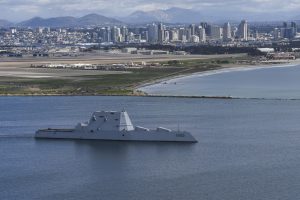U.S. defense firm Raytheon has been awarded a two-year, $121.5 million contract modification to perform logistics and engineering services for the Zumwalt-class – the U.S. Navy’s largest and technologically most advanced class of guided-missile destroyers – the U.S. Department of Defense (DoD) announced on February 19.
The deal modifies an earlier contract awarded in 2017. Work under the modification will take place in Rhode Island, Massachusetts, Maine, Indiana, New Hampshire, and California through January 2021.
Raytheon is also overseeing installation and activation work of the combat systems of all three 16,000-ton Zumwalt-class destroyers, which feature distinct wave-piercing tumblehome hulls and a stealth design meant to reduce the ships’ radar cross-section.
The first-of-class USS Zumwalt (DDG 1000) was commissioned in October 2016. The second Zumwalt-class destroyer, the USS Michael Monsoor (DDG 1001), was commissioned in January 2019, while the third ship of the class, the future USS Lyndon B. Johnson (DDG 1002) was christened in April 2019 and is slated to be commissioned in 2021.
Notably, the U.S. DoD briefly considered abandoning construction of the last Zumwalt class vessel as a cost saving measure in 2015. However, the Pentagon abandoned the plan after it became clear that cancelling the destroyer might end up costing the U.S. Navy more than continuing construction of the surface combatant.
The Zumwalt class is about 100 feet longer and 13 feet wider than the Arleigh Burke class of guided missile destroyers. The three ships are powered by two Rolls-Royce main turbine generators and two Rolls-Royce auxiliary turbine generators and can reach top speeds of up to 33.5 knots (38.6 mph).
As I noted repeatedly in the past, the Zumwalt class still lacks the proper ammunition for its main guns and it remains incapable of executing land-strike missions:
Zumwalt-class destroyers are equipped with 80 MK57 vertical launch tubes, each capable of accommodating one to four SM-1, SM-2, and SM-6, or Tomahawk land-attack missiles. The stealth destroyers will also be armed with new long-range anti-ship missiles such as the Maritime Strike Tomahawk following a change of the mission requirements of the Zumwalt-class from a land-attack platform to surface warfare in November 2017.
The Zumwalt class may also eventually be armed with lasers and other high-tech weaponry given the class’ integrated power system, which can produce approximately 78 megawatts of power – almost as much as a nuclear-powered aircraft carrier.
The Government Accountability Office (GAO) in its annual survey of U.S. Department of Defense (DoD) acquisitions criticized several aspects of the Zumwalt-class program last May, including the lack of a suitable projectile for the Advanced Gun Systems, design issues, and the ambitious delivery schedule.

































